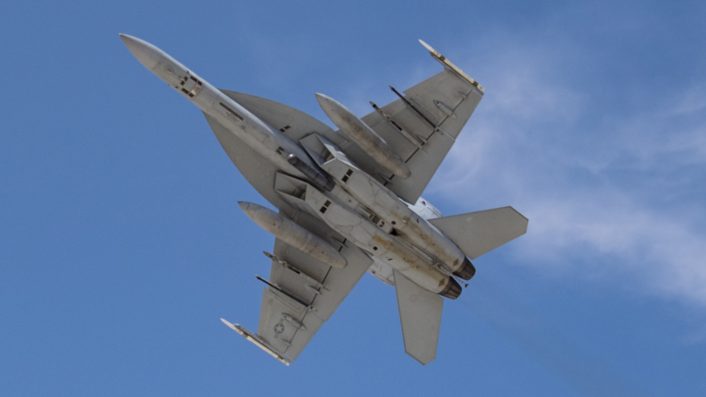The successful completion of the initial flight testing is a further step towards deploying the LITENING pod to the fleet.
The LITENING targeting pod has successfully completed its initial flight testing on the U.S. Navy’s F/A-18 E/F Super Hornet, marking a vital milestone toward full operational deployment, Northrop Grumman announced on Oct. 31, 2024. These tests challenged the electro-optical/infrared pod with rigorous maneuvers that simulate real-world mission conditions.
In 2022, the U.S. Navy selected the battle-tested LITENING ATP to replace the legacy targeting pods on the Super Hornet fleet. Previously, Super Hornets relied on the AN/ASQ-228 ATFLIR (Advanced Tactical Forward-Looking Infrared) system. However, since 2019, the Navy has explored alternatives to improve or replace the existing EO/IR pods, responding to concerns about ATFLIR’s readiness and sustainment costs.
Equipped with advanced daylight and infrared sensors, the LITENING pod delivers high-definition video across multiple wavelengths, offering a significant advantage in both surveillance and precision targeting missions.

The naval service plans to integrate the pod across the fleet, expanding on its use with the legacy Hornet and AV-8B Harrier jets in the U.S. Marine Corps, along with various U.S. Air Force, Air National Guard, and international aircraft. All the photos released by Northrop Grumman so far show the pod mounted on the Super Hornet’s centerline pylon under the fuselage, though it can also be installed on the left cheek station. Previously, mounting the legacy pod on this station limited the Hornet’s ability to carry external stores on the left inner pylon, as the pod’s line of sight required a clear field of view.
The first flight of the pod on the U.S. Navy’s F/A-18F Super Hornet was announced on Sept. 7, 2022. At the time, the electro-optical infrared sensor system, already in wide use globally for targeting and surveillance, had amassed over 3 million hours in operation, including more than 1 million combat hours, with an availability rate above 95%.

According to Northrop Grumman, during the first flight two years ago, the LITENING ATP allowed pilots to perform maneuvers similar to those encountered in combat, such as ground moving target tracking, air-to-air target acquisition, and designation. Pilots also tested the pod’s eye-safe training laser mode, enabling realistic practice with ground-based combat controllers. Notably, these operations were conducted without prior specialized training, demonstrating the pod’s intuitive interface—a result of close collaboration with the aviation community.
“This initial flight showcased LITENING’s capacity to quickly bring new, modular mission capabilities to the Super Hornet,” commented James Conroy, then vice president of navigation, targeting, and survivability at Northrop Grumman. “With digital video, autonomous target tracking, and laser sensors, LITENING provides Naval aviators with new tactical advantages for land and sea operations today. Additionally, its modular design allows for continued capability enhancements to meet future mission needs.”

A vital edge in combat
The LITENING targeting pod stands out as a game-changing tool in modern combat, providing pilots with enhanced situational awareness and critical data to make rapid, life-saving decisions. Tim Grebs, Northrop Grumman program manager and former A-10 Thunderbolt II pilot with 15 years of service in the U.S. Air Force, underscored its importance based on his own experiences in Afghanistan on the company’s website. Mounted under a plane’s wing, LITENING’s electro-optical and infrared (EO/IR) sensors capture high-definition video in visible and infrared light, enabling aircrews to detect, identify, and track potential threats even in challenging environments. With this technology, pilots gain a real-time visual of the battlefield, whether it’s day or night, which Grebs explained is invaluable for locating and engaging targets more quickly and effectively.
One mission in September 2010 exemplifies the pod’s life-saving capabilities.
Grebs was patrolling with another pilot over Afghanistan’s Helmand River valley, an area notorious for conflict due to poppy cultivation funding insurgent activity. Grebs vividly recalled his friend being killed there only months earlier, making this mission especially poignant. As the sun set, he and his wingman received a distress call from Marines taking heavy fire from Taliban fighters concealed nearby. The Marines were outnumbered and unable to locate the enemy’s position, increasing their vulnerability. Grebs initially relied on daylight cameras but couldn’t identify the source of enemy fire. As he switched to infrared, he began identifying “hot spots” on his display—confirming the enemy’s positions just across a canal from the Marines. This switch enabled him to relay precise coordinates to ground forces, helping them focus their firepower on enemy fighters hidden under cover.
This rapid communication was pivotal in preventing American casualties. Grebs and his wingman, now certain of the enemy’s location, made two low-altitude passes to engage the threat, neutralizing it in just minutes. Without the LITENING pod, he estimated the encounter could have dragged out for 15 to 20 minutes, a period in which American lives could have been lost.
“In combat, every second matters. Without the pod, we might not have had such a precise or quick response.”
He credited the pod’s advanced sensors and ease of use with enabling him to operate in real-world scenarios with minimal additional training.
Grebs’ story demonstrates how Northrop Grumman’s LITENING pod serves as a crucial extension of a pilot’s situational awareness and a force multiplier for troops on the ground. The system’s flexibility and advanced EO/IR capabilities make it a decisive asset in not only the U.S. military but also for international allies. “When I think of EO/IR systems, I think of two words: ‘situational awareness,'” Grebs stated, adding that the pod’s adaptability for both surveillance and targeting allows pilots to respond effectively to rapidly changing conditions. For Grebs and others in similar high-stakes scenarios, the LITENING pod has made the difference between life and death on the battlefield, underscoring the technology’s crucial role in modern air combat.









